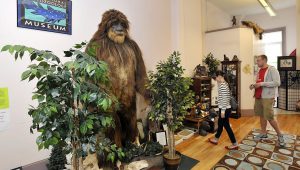If you’ve ever been on a road trip, you’ve almost certainly seen them: signs trying to get you to turn off an obscure exit to see the “world’s largest” of something. For the curious, or the easily amused, it’s always a tempting option.
These pit stops are not only fun, but they can even be educational. Whether you’re teaching your own kids, or looking for something to bring back to your classroom, we’ve got a few great ideas on how to incorporate your summer travel into lesson plans.
Here are 10 fascinating roadside attractions that can add a little spice to your lessons:
Cabazon Dinosaurs
Cabazon, California
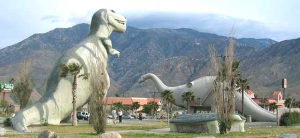
Why you should take the exit: The Cabazon Dinosaursmight be the most iconic roadside attractions in the United States. The 150-feet-long Dinny the Dinosaur and the 65-feet-tall Mr. Rex were featured in the 1985 film Pee-Wee’s Big Adventure, for one.
What to ask your students:Are the dinosaurs the correct length/height? How have our impressions of dinosaurs changed since these statues were erected (feathers, etc.)?
Cryptozoology Museum
Portland, Maine
Why you should take the hour: The Cryptozoology Museum, maybe the only such museum in the world, is a favorite for speculators around the world. Specimens of cryptozoology–or the “study of hidden or unknown animals”–fill the space, which was expanded into a museum from the founder’s private collection.
Here, you’ll find “evidence” of the existence of creatures like the Yeti, bigfoot, and lake monsters, along with others like mermaids and furry fish. “Life-sized” replicas, footprints, hair samples, and movie props decorate the museum.
What to tell your students: This is an interesting way to introduce cryptozoology to your students, and discuss the scientific method. Even the most ardent scientist will have fun looking at holes in the evidence here, and your students will have a blast as well.
Octopus Tree
The Oregon Coast, Oregon
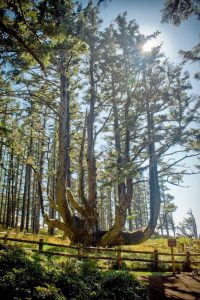
Why you should take the hike: Unlike the Cabazon Dinosaurs or the questionable specimens at the cryptozoology museum, the Octopus Treeis a real-life natural marvel. With a 50-foot circumference at the base, the massive spruce tree is over 300 years old. But that’s not all that sets it apart: The tree has no central trunk, instead sprawling out with several wide trunks that have given the tree its name.
No one really knows how the Octopus Tree turned out so weird, but scientists speculate that it was shaped by environmental factors or “trained” by American Indians.
What to ask your students: What could have caused this? What influences the size and shape of a plant? What is “training,” and how do humans influence their environment?
Giant Gorilla
Leicester, Vermont
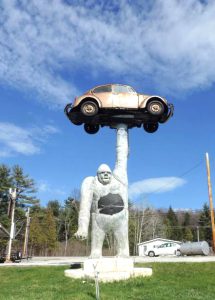 Why you should mark it on your map: The concrete and steel Giant gorilla(whose name is Queen Connie, thank you very much) holds a Volkswagen Bug above her head with one hand, and the other is good for sitting.
Why you should mark it on your map: The concrete and steel Giant gorilla(whose name is Queen Connie, thank you very much) holds a Volkswagen Bug above her head with one hand, and the other is good for sitting.
Erected in 1987 to promote a nearby used car dealership, Connie is a little worn down, and the Bug, which was placed on her hand with a crane, has seen better days as well.
What to ask your students: How does the Volkswagen stay up there? Where is its center of gravity? What are the structural requirements for the gorilla to keep the car where it is?
Redstone Rocket
Warren, New Hampshire
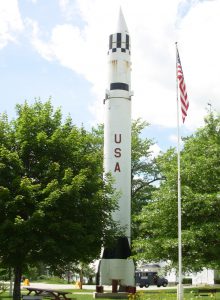
Why you should head to Warren: A little piece of space and engineering history has sat in little Warren, New Hampshire since 1971. The Redstone rocketis one of the model that carried the first live nuclear warhead and was used to propel Alan Shepard into space. Discontinued in 1964, today this empty rocket sits right in the town square.
What to tell your students: Talk about the significance of this particular rocket in the history of space exploration. How was its design effective, and why was it discontinued? How do rockets work? Make model rockets that replicate the Redstone model.
Carhenge and Foamhenge
Alliance, Nebraska and Centreville, Virginia
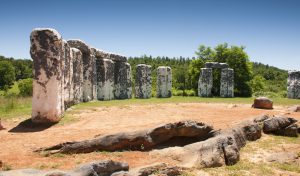
Why you should add both states to your itinerary: Both of these attractions replicate Stonehenge to varying degrees. Built in 1987, Carhengeconsists of 39 cars spray-painted silver, and is said to match Stonehenge in terms of its size and stone placement.
Foamhengegoes a bit further, with each styrofoam “stone” replicating the shape of the original stone in England, and the stones are placed at the correct astronomical coordinates. Created in 2004, Foamhenge started out as an April Fool’s joke, but it’s been maintained ever since due to popular demand.
What to ask your students: What significance does Stonehenge have in Western culture? Where does Stonehenge fall in the Arthurian legends, and why does Arthur still resonate?
Nuclear Waste Adventure Trail
Weldon Spring, Missouri
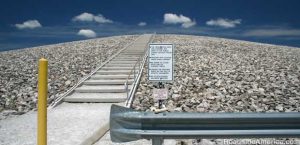 Why you should head there:If the name sounds frightening, that’s because it is: The Nuclear Waste Adventure Trailwas the site of a Cold War-era plant that refined uranium and was abandoned in the 60s.
Why you should head there:If the name sounds frightening, that’s because it is: The Nuclear Waste Adventure Trailwas the site of a Cold War-era plant that refined uranium and was abandoned in the 60s.
In the 80s, the EPA had to decide what to do with the waste and entombed it at this 54-acre site, covering the mercury, radioactive uranium, asbestos, etc. with rocks that you can now stroll through at your leisure.
What to tell your students: Talk about the Cold War and the threat of nuclear war for Americans in the 60s. How did that affect popular culture, politics, etc.? Who was Bert the Turtle, and how did he save a generation?
Salvation Mountain
Niland, California
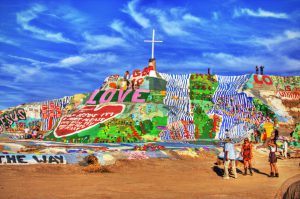 Why you should stop the car: This “mountain” is actually a 50-foot-high, 150-foot-wide adobe hill, colored with thousands of gallons of (lead-free) paint. The artist created Salvation Mountainin the Southern California desert as a massive tribute to God.
Why you should stop the car: This “mountain” is actually a 50-foot-high, 150-foot-wide adobe hill, colored with thousands of gallons of (lead-free) paint. The artist created Salvation Mountainin the Southern California desert as a massive tribute to God.
Talk to your students about:Where art and nature meet, and how art is used to make a statement. Have them make pet rocks!
Cadillac Ranch
Amarillo, Texas
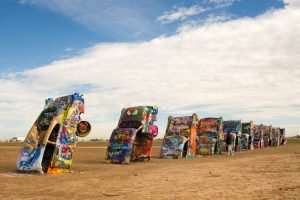 Why you should go out of your way: Cadillac Ranchis an art installation along the famous Route 66. It consists of several old Cadillacs stuck nose-first in the ground in a line, all at the same angle of the pyramids of Giza.
Why you should go out of your way: Cadillac Ranchis an art installation along the famous Route 66. It consists of several old Cadillacs stuck nose-first in the ground in a line, all at the same angle of the pyramids of Giza.
Created in 1974 as part of the Ant Farm art group, the Ranch is super colorful, and completely interactive: Visitors are encouraged to continue decorating the cars, which are repainted often, and many have taken pieces of the cars as souvenirs.
What to tell your students: Talk about art installations as experiences that you can walk through and touch. Ask them what it means that people other than the original artist are allowed to participate in the installation’s continued creation.
Enchanted Highway
Gladstone, North Dakota
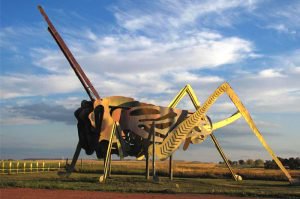
Why you should take a detour: The Enchanted Highwayis a series of scrap metal structures running down 32 miles of highway. Begun in 1989, it features giant metal deer, geese, tin people, and pheasants. Plus: Gift shop!
What to talk about with your students: “Found art”, and how scrap metal art takes something supposedly ugly and useless and makes it into something unique.
Looking to take your students on a group tour of some of the U.S.’s biggest attractions? Check out our North American tours!



